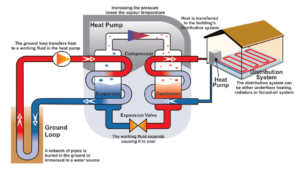In green buildings, the focus of HVAC systems shifts towards strategies that optimize comfort and efficiency while minimizing environmental impact.
Here are the 7 key components that make up a green HVAC system:
High-Efficiency Equipment:
Green buildings prioritize using HVAC equipment with high Energy Efficiency Ratios (EER) for cooling and Coefficient of Performance (COP) for heating. This ensures the system uses less energy to deliver the desired comfort level. Examples include:
-
- High-efficiency air conditioners and heat pumps
- Variable-speed drives (VSDs) on fans and pumps to adjust operational speed based on real-time needs
Proper Building Envelope Design:
A well-designed building envelope reduces the heating and cooling load on the HVAC system. This can involve:
-
- Proper insulation in walls, roofs, and floors to minimize heat transfer.
- Air sealing techniques to prevent drafts and unwanted air leakage.
- Strategic window placement to maximize natural light and ventilation while minimizing unwanted heat gain or loss.
Smart Controls:
Smart thermostats, occupancy sensors, and building automation systems optimize HVAC operation. These features can:
-
- Automatically adjust temperature settings based on occupancy or time of day.
- Learn occupant preferences and adjust settings for peak efficiency.
- Monitor system performance and identify opportunities for further optimization.
Renewable Energy Integration:
Some green buildings incorporate renewable energy sources like solar power to run HVAC systems. This can involve:
-
- Solar panels to generate electricity that can power chillers, heat pumps, or ventilation fans.
- Geothermal heat pumps that utilize the stable temperature of the earth for heating and cooling.

Energy Recovery Ventilation (ERV):
In green buildings, maintaining good indoor air quality is crucial. However, excessive ventilation can waste energy. Energy recovery ventilators (ERVs) address this by:
-
- Transferring heat and moisture between incoming fresh outdoor air and outgoing stale exhaust air.
- Pre-conditioning the incoming fresh air using the outgoing air stream, reducing the energy needed to reach the desired temperature and humidity levels.
Dedicated Outdoor Air Systems (DOAS):
In some cases, green buildings might utilize Dedicated Outdoor Air Systems (DOAS). These systems:
-
- Pre-treat 100% fresh outdoor air using high-efficiency filters, dehumidification, and heating/cooling elements.
- Then distribute this conditioned fresh air throughout the building.
- DOAS can be more energy-efficient than traditional mixing units, especially in climates with significant temperature or humidity extremes.
Regular Maintenance:
Regular maintenance and inspections of HVAC systems ensure optimal performance and efficiency. This can involve:
-
- Cleaning air filters regularly to prevent airflow restrictions.
- Scheduling preventive maintenance to identify and address potential issues before they escalate.
- Monitoring system performance and making adjustments as needed.
By implementing these components, green buildings achieve significant improvements in HVAC system efficiency and environmental impact. This translates to lower operational costs, a smaller carbon footprint, and a more sustainable built environment.
Looking to install a commercial HVAC System or Duct work in your Business Area?
Contact Vipul Ac to learn about our HVAC Service
Call +91 8000092000 Today.

